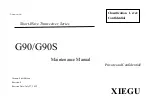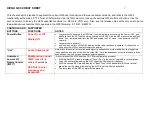
33
RF Exposure:
This equipment complies with FCC radiation exposure limits set forth for an uncontrolled environment. This equipment is in direct contact with
the body of the user under normal operating conditions. This transmitter must not be co-located or operating in conjunction with any other
antenna or transmitter.
Under Industry Canada regulations, this radio transmitter may only operate using an antenna of a type and maximum (or lesser) gain approved
for the transmitter by Industry Canada. To reduce potential radio interference to other users, the antenna type and its gain should be so chosen
that the equivalent isotropically radiated power (e.i.r.p.) is not more than that necessary for successful communication.
This radio transmitter and has been approved by Industry Canada to operate with the antenna types listed below with the maximum
permissible gain and required antenna impedance for each antenna type indicated. Antenna types not included in this list, having a gain greater
than the maximum gain indicated for that type, are strictly prohibited for use with this device.
Quarter Wave Whip Antenna, 5.19dBi gain, 50 Ohms
This device complies with Industry Canada license-exempt RSS standard(s). Operation is subject to the following two conditions: (1) this device may
not cause interference, and (2) this device must accept any interference, including interference that may cause undesired operation of the device.
“This device operates on a no-protection, no-interference basis. Should the user seek to obtain protection from other radio services operating in the
same TV bands, a radio licence is required. For further details, consult Innovation, Science and Economic Development Canada’s document Client
Procedures Circular CPC-2-1-28, Voluntary Licensing of Licence-Exempt Low-Power Radio Apparatus in the TV Bands.”
Conformément à la réglementation d'Industrie Canada, le présent émetteur radio peut fonctionner avec une antenne d'un type et d'un gain
maximal (ou inférieur) approuvé pour l'émetteur par Industrie Canada. Dans le but de réduire les risques de brouillage radioélectrique à
l'intention des autres utilisateurs, il faut choisir le type d'antenne et son gain de sorte que la puissance isotrope rayonnée équivalente (p.i.r.e.)
ne dépasse pas l'intensité nécessaire à l'établissement d'une communication satisfaisante.
Le présent émetteur radio (PR6-XRT) a été approuvé par Industrie Canada pour fonctionner avec les types d'antenne énumérés ci-dessous et
ayant un gain admissible maximal et l'impédance requise pour chaque type d'antenne. Les types d'antenne non inclus dans cette liste, ou dont
le gain est supérieur au gain maximal indiqué, sont strictement interdits pour l'exploitation de l'émetteur.
Le présent appareil est conforme aux CNR d'Industrie Canada applicables aux appareils radio exempts de licence. L'exploitation est autorisée aux
deux conditions suivantes : (1) l'appareil ne doit pas produire de brouillage, et (2) l'utilisateur de l'appareil doit accepter tout brouillage
radioélectrique subi, même si le brouillage est susceptible d'en compromettre le fonctionnement.
"Cet appareil fonctionne sur une base sans protection, sans interférence. Si l'utilisateur cherche à obtenir une protection contre d'autres services de
radio fonctionnant dans les mêmes bandes de télévision, une licence radio est requise. Pour de plus amples renseignements, veuillez consulter le
document CPC-2-1-28, Procédures à l'intention des clients, intitulé Procédures à l'intention des clients, intitulé «Licence volontaire d'appareils radio
à faible puissance exempts de licence dans les bandes de télévision»
USA - FCC Part 74, FCC Identifier PR6ZMT3 PHANTOM
Canada - Industry Canada RSS 210, IC:12755A-ZMT3 PHANTOM
Zaxcom Digital Wireless are protected under following patent #’s:
4,327,066 / 7,711,443 / 7,929,902 /
8,385,814 / 8,878,708 / 8,842,854
NOTICE:
Most users do not need a license to operate a wireless microphone system. Nevertheless, operating a microphone system without a license is
subject to certain restrictions:
•
the system may not cause harmful interference,
•
it must operate at a low power level (not in excess of 50 milliwatts),
•
it has no protection from interference received from any other device.
Purchasers should also be aware that the FCC is currently evaluating the use of wireless microphone systems, and these rules are subject to
change. For more information, call the FCC at 1-888-CALL-FCC (TTY: 1-888-TELL-FCC) or visit the FCC’s wireless microphone website at:
www.fcc.gov/cgb/wirelessmicrophones
To operate wireless microphone systems transmitting with greater than 50mW of radiated power, you
must qualify as a Part 74 user and be licensed.
This alert does
NOT
apply to Part 74 users
Summary of Contents for ZMT-267
Page 29: ...Zaxcom ZMT3 Phantom 2 Antenna Cutting Chart 29...
Page 34: ...34...


































